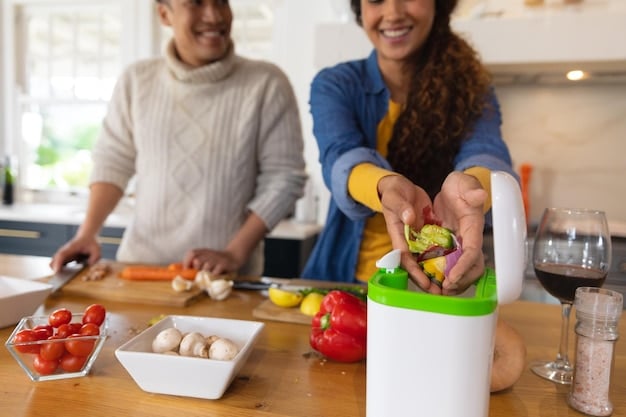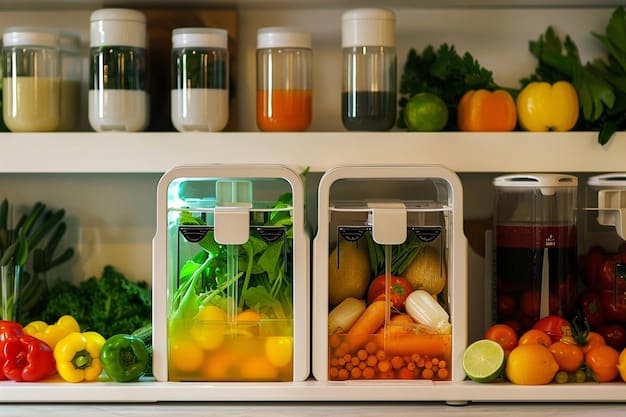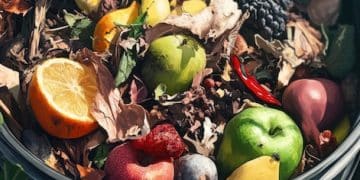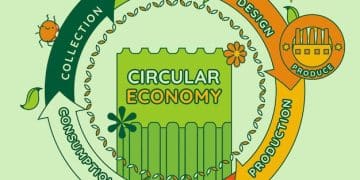How US Households Can Cut Food Waste by 25% in 2025

Reducing food waste by 25% in US households by 2025 is achievable through strategic planning, mindful consumption habits, and community engagement, promoting both economic savings and environmental sustainability.
In the United States, an alarming amount of food is wasted annually in households, contributing significantly to environmental degradation and economic loss. Understanding how can US households reduce food waste by 25% in 2025 is not just an ambitious goal, but a crucial step towards a more sustainable future. This comprehensive guide will explore practical strategies and innovative solutions to empower every American home to make a substantial impact.
Understanding the Scale of the Problem
Food waste is a pervasive issue in the United States, extending far beyond simply uneaten leftovers. It encompasses food that spoils before consumption, items discarded due to confusion over date labels, and even large quantities of edible produce left in fields because they don’t meet aesthetic standards. This systemic problem has profound implications, affecting everything from individual household budgets to global climate change and resource depletion.
The sheer volume of food wasted annually in the U.S. is staggering. Estimates suggest that nearly 40% of the food produced in the country goes uneaten. This translates to billions of pounds of food filling landfills, where it decomposes and releases methane, a potent greenhouse gas significantly more impactful than carbon dioxide over a shorter timeframe. Beyond the environmental cost, there’s a substantial economic burden. American families collectively lose billions of dollars each year on food that is ultimately thrown away, money that could otherwise be used for other necessities or savings.
The Environmental Impact of Food Waste
The journey of food from farm to fork involves a complex web of resources: water for irrigation, energy for cultivation, transportation, and refrigeration, and land for farming. When food is wasted, all these resources are also wasted. The environmental footprint of food waste includes:
- Excessive Greenhouse Gas Emissions: As noted, methane from landfills is a major contributor to climate change.
- Water Depletion: Producing food is incredibly water-intensive. Wasting food means wasting the vast amounts of water used in its growth and processing.
- Land Use and Deforestation: Expanding agricultural land often leads to deforestation, destroying vital ecosystems and biodiversity.
- Pollution from Pesticides and Fertilizers: The overuse of these chemicals in food production can contaminate soil and water systems.
Addressing food waste is therefore not just about conscious consumption; it’s about mitigating a significant environmental crisis. A 25% reduction in household food waste would translate into a considerable decrease in our collective carbon footprint, conserve precious natural resources, and alleviate pressure on landfill infrastructure. It’s a tangible step towards fulfilling broader sustainability goals for the nation.
Economic Losses at the Household Level
For individual households, the economic impact of food waste can be surprisingly large, often hidden within weekly grocery bills. Many families don’t realize how much valuable food, and thus money, they’re literally throwing away. The exact amount varies, but studies indicate that an average American family of four could save hundreds, if not thousands, of dollars annually by simply reducing their food waste.
This economic drain is often a result of several factors, including impulse purchases, poor meal planning, misunderstanding expiration dates, and improper food storage. When coupled with rising food prices, the financial implications become even more pronounced. By implementing effective food waste reduction strategies, households can unlock significant savings, freeing up funds for other priorities or investments. This financial incentive can be a powerful motivator, driving behavioral changes that benefit both the household budget and the environment.
Mastering Meal Planning and Smart Shopping
The foundation of significant food waste reduction begins long before food enters your home. Strategic meal planning and smart shopping practices are pivotal. By taking a proactive approach to what you buy and how you plan to use it, you can dramatically minimize spoilage and unnecessary purchases, directly contributing to the 25% reduction goal by 2025.
Meal planning involves more than just deciding what to eat; it’s about optimizing your entire food consumption cycle. Start by reviewing what you already have in your pantry, refrigerator, and freezer. This prevents buying duplicates and ensures older items are used first. Next, plan meals around ingredients that are perishable or in season, allowing for flexibility to use up leftovers or items nearing their expiration. This methodical approach ensures that every item purchased has a purpose and is likely to be consumed.
Creating a Weekly Meal Plan
A well-structured weekly meal plan is your first line of defense against food waste. This practice not only streamlines your grocery trips but also ensures that you buy only what you need. Begin by planning all your meals for the week, including breakfasts, lunches, dinners, and snacks. Consider using ingredients that can be repurposed in different dishes, like roasted chicken that becomes a salad topping the next day.
- Take Inventory: Before planning, check your current food supply.
- Plan for Leftovers: Incorporate “leftover nights” or plan for ingredients to be repurposed.
- Seasonal Eating: Prioritize in-season produce, which is often fresher and more affordable.
Once your plan is set, create a detailed grocery list based solely on the ingredients required for these meals. Stick to this list diligently while shopping, resisting impulse buys that often lead to excess perishable items. This disciplined approach ensures that every item in your cart serves a purpose in your intended culinary creations for the week.
Smart Shopping Strategies
Shopping smart is about making informed decisions at the grocery store. It goes hand-in-hand with meal planning, ensuring that you purchase only what’s necessary and avoid overbuying, which is a major contributor to household food waste. One key strategy is to always shop with a list, ideally one that corresponds to your weekly meal plan.
Beyond the list, pay attention to the quantities you buy. For highly perishable items, buy smaller amounts more frequently rather than large bulk packages that might spoil before you can consume them. Utilize store loyalty programs or apps that provide personalized discounts on items you actually use, rather than being swayed by generic “buy one, get one free” offers that encourage excessive purchasing of items you might not need. Consider shopping at farmers’ markets for fresh produce, where you can buy exactly the quantity you desire, often supporting local agriculture in the process.
Revolutionizing Food Storage and Preservation
Even with meticulous planning and smart shopping, food waste can occur if items are not stored correctly. Proper storage and effective preservation techniques are critical to extending the shelf life of your groceries, ensuring they remain fresh and edible for as long as possible. This area offers significant potential for contributing to the 25% food waste reduction target.
Many common household foods spoil prematurely due to incorrect storage conditions. For instance, fruits and vegetables often have specific temperature and humidity requirements. Separating certain fruits that release ethylene gas (like apples and bananas) from sensitive produce (like leafy greens) can prevent premature ripening and spoilage in your refrigerator. Understanding these nuances can significantly prolong the usability of your fresh produce.

Optimal Storage Techniques for Fresh Produce
Maximizing the life of your fresh fruits and vegetables is crucial. Not all produce should be stored in the same way. Leafy greens, for example, thrive in slightly damp conditions inside a sealed bag or container in the crisper drawer. Berries, on the other hand, should be washed just before consumption and stored unwashed in a single layer in the refrigerator to prevent mold. Root vegetables like carrots and potatoes prefer cool, dark, and dry places, but always keep potatoes and onions separate from each other, as their gases can cause spoilage.
- Separate Ethylene Producers: Store apples, bananas, and tomatoes away from other fruits and vegetables.
- Proper Humidification: Use crisper drawers appropriately for high and low humidity produce.
- Air Circulation: Ensure certain items, like onions, have good air circulation.
Understanding the specific needs of each item can prevent unnecessary waste. Investing in proper storage containers, such as airtight glass containers or reusable silicone bags, can also play a significant role in maintaining freshness and preventing spoilage, ultimately saving money and reducing waste.
Embracing Food Preservation Methods
When fresh food is abundant or nearing its peak, preservation techniques become invaluable tools in the fight against waste. Freezing is one of the easiest and most effective methods for extending the life of many foods, from fruits and vegetables to cooked meals and bread. Blanching vegetables before freezing helps retain their color, texture, and nutritional value. For fruits, simple pureeing or slicing for smoothies can be effective.
Beyond freezing, consider other methods like pickling, fermenting, canning, or dehydrating. These ancient practices are experiencing a resurgence and are excellent ways to preserve excess produce, turning it into delicious and long-lasting pantry staples. Learning even a few basic preservation techniques can transform your approach to food, ensuring that seasonal gluts don’t translate into waste but rather into future meals or treats. These methods not only reduce waste but can also introduce new flavors and culinary skills into your household.
Creative Cooking and Leftover Management
Even with the best planning and storage, there will inevitably be leftovers or ingredients that seem to be a bit past their prime. This is where creative cooking and effective leftover management become essential. Shifting your mindset from seeing these as “waste” to viewing them as “opportunities” can unlock delicious possibilities and contribute significantly to reaching the 25% food waste reduction goal.
Many kitchen scraps or slightly wilted vegetables are perfectly edible and contain valuable nutrients. The key is to know how to transform them. For example, vegetable trimmings and bones can be simmered to create a rich, flavorful broth – a staple for future soups and stews. Overripe fruits are ideal for smoothies, baked goods, or homemade jams, preventing them from ending up in the trash.
Transforming Leftovers into New Meals
Leftovers are often perceived as boring, but with a little creativity, they can be transformed into exciting new dishes. Instead of simply reheating the same meal, think about how components can be repurposed. For example, leftover roasted chicken can become the protein in a stir-fry, tacos, or a hearty soup. Cooked rice can be turned into fried rice or a base for a grain bowl. Even leftover mashed potatoes can be used to thicken soups or form savory patties.
- Deconstruct and Rebuild: Look at individual components and how they can be used differently.
- Add Fresh Ingredients: Elevate leftovers with new spices, herbs, or fresh vegetables.
- “Leftover Night” Philosophy: Designate a night where everyone gets creative with available leftovers.
The trick is to have a flexible approach and be open to culinary experimentation. By seeing leftovers as versatile ingredients rather than a burden, you not only reduce waste but also save time and money on future cooking efforts. It’s a win-win for both your wallet and the planet.
Utilizing Scraps and “Ugly” Produce
A significant amount of food waste occurs because of aesthetic standards or the discarding of parts generally considered “scraps.” Yet, carrot tops, broccoli stalks, beet greens, and even potato peels are often edible and nutritious. Embracing “nose-to-tail” or “root-to-stem” cooking for produce means using as much of the plant as possible.
Consider making pesto from carrot tops, stir-frying broccoli stalks, or adding beet greens to a sauté. Fruit and vegetable peels can often be used to infuse water or make flavored vinegars. Furthermore, don’t shy away from “ugly” produce. Supermarkets often discard fruits and vegetables that are misshapen or slightly bruised but are perfectly edible and delicious. Buying these items, perhaps from specialized services or farmers’ markets, not only saves them from the landfill but often comes at a discounted price, offering further savings to your household.
Composting and Responsible Disposal
Even with the most diligent efforts in meal planning, smart shopping, and creative cooking, some food waste is inevitable. For these unavoidable scraps, responsible disposal through composting becomes paramount. Composting diverts organic waste from landfills, significantly reducing methane emissions and creating valuable nutrient-rich soil amendments for gardens.
Food waste that ends up in landfills contributes to a cycle of environmental harm. When organic matter decomposes in an anaerobic (oxygen-free) environment, it produces methane, a potent greenhouse gas. Composting, conversely, is an aerobic process, where microbes break down organic materials in the presence of oxygen, producing carbon dioxide (a less potent greenhouse gas) and rich compost, which improves soil health and reduces the need for chemical fertilizers.
Setting Up a Home Composting System
Establishing a home composting system is an accessible way for households to manage their organic waste. There are various methods, from outdoor compost bins to indoor worm farms (vermicomposting). The choice depends on your living situation, available space, and level of commitment. Outdoor bins are suitable for yards, breaking down a wide range of organic materials including fruit and vegetable scraps, coffee grounds, tea bags, and yard waste.
For apartment dwellers or those with limited outdoor space, vermicomposting offers a compact solution. Worms efficiently process food scraps into nutrient-rich castings. Whichever method you choose, it’s essential to maintain a balance of “greens” (nitrogen-rich items like food scraps) and “browns” (carbon-rich materials like dry leaves and cardboard) for optimal decomposition. Starting a compost system effectively shifts waste from disposal to resource creation, directly contributing to sustainability goals.
Community Composting and Local Initiatives
For households unable to set up their own composting system, community composting programs offer an excellent alternative. Many municipalities and local organizations provide drop-off points for food scraps, often converting them into compost for local parks, farms, or community gardens. Some areas even offer curbside collection services for organic waste, similar to recycling programs.
Exploring these local initiatives is crucial. By participating, you contribute to a larger circular economy, ensuring that your food scraps become a valuable resource rather than a pollutant. Beyond formal programs, consider connecting with local farmers or gardeners who might be interested in collecting your food waste for their own composting efforts. These community-level solutions empower individuals to make a difference collectively, scaling up the impact of individual household efforts towards the 25% reduction goal.
Education and Behavioral Change
Achieving a 25% reduction in household food waste by 2025 goes beyond simply implementing practical strategies; it requires a fundamental shift in perception and behavior. Education plays a pivotal role in this transformation, raising awareness about the scale of the problem and empowering individuals with the knowledge and motivation to change their habits. Behavioral change means moving from ingrained patterns of consumption and disposal to more mindful, sustainable practices.
This includes understanding the true cost of food waste—not just financially, but ethically and environmentally. Many individuals are unaware of how much food they actually discard or the resources that went into its production. Providing clear, actionable information about the impact of food waste and the simple steps that can be taken to prevent it is crucial. This awareness can be the catalyst for families to re-evaluate their relationship with food.
Understanding Date Labels
One of the most significant contributors to household food waste is consumer confusion surrounding date labels. Terms like “sell by,” “best by,” “use by,” and “expires on” are often misinterpreted, leading to perfectly edible food being thrown away prematurely. “Sell by” dates are primarily for retailers, indicating when the store should remove the product from shelves. “Best by” or “best if used by” refers to peak quality, not safety. Food can often be safely consumed well past this date.
Only “use by” or “expires on” dates typically indicate a safety limit, usually for highly perishable items. Educating consumers on the true meaning of these labels could significantly reduce a major stream of food waste. Encourage households to rely more on their senses—smell, sight, and touch—to determine if food is still good, rather than blindly following potentially misleading date labels. This empowers consumers to make informed decisions about food safety and reduces unnecessary waste.
Promoting Mindful Consumption
Mindful consumption extends beyond just food; it’s a philosophy applied to all aspects of life. In the context of food waste, it means being more present and intentional about how we acquire, prepare, and consume food. This involves appreciating the effort and resources that went into producing our meals, fostering a sense of gratitude that naturally discourages waste.

Practically, mindful consumption can involve savoring each bite, paying attention to hunger cues to avoid overeating, and being deliberate about portion sizes. It also means reducing impulse purchases at the grocery store and truly valuing the food we have. Encouraging children to participate in cooking and understanding the food system can instill these values early on. By cultivating a more mindful approach to food, households can develop sustainable habits that lead to lasting reductions in waste and foster a deeper connection to their food sources.
Policy and Community Support
While individual household efforts are vital, achieving a 25% reduction in food waste by 2025 also requires supportive policies and robust community initiatives. Governments and local organizations can create an enabling environment that makes it easier for households to adopt waste-reducing behaviors, providing infrastructure, incentives, and educational programs.
Policy interventions can range from standardizing date labels across the industry to implementing clearer guidelines for food donation. Many states and municipalities are already exploring and enacting laws that divert organic waste from landfills through mandatory composting or commercial food waste bans. These top-down approaches complement bottom-up household efforts, creating a comprehensive strategy for waste reduction.
Government Incentives and Regulations
Government bodies at federal, state, and local levels can play a crucial role in tackling food waste through various incentives and regulations. One effective policy is the standardization of food date labels, reducing consumer confusion and preventing the premature disposal of edible food. Clarity on “best by” vs. “use by” dates dramatically impacts household behavior.
Other potential incentives include tax breaks for businesses that donate surplus food, grants for community composting programs, or subsidies for households purchasing tools like home composters. Regulations could involve mandates for commercial food waste separation, encouraging restaurants and institutions to divert their organic waste. By establishing clearer frameworks and providing financial encouragement, governments can significantly accelerate the adoption of food waste reduction practices across the nation, supporting households in achieving their individual goals.
Role of Local Organizations and Community Programs
Local non-profits, community gardens, food banks, and educational institutions are indispensable partners in the fight against food waste. They often act as vital bridges, connecting surplus food with those in need, offering practical workshops, and creating localized composting solutions. Many food banks actively rescue edible surplus food from grocery stores, restaurants, and farms, redistributing it to combat food insecurity and prevent waste simultaneously.
Community gardens and urban farms can serve as demonstration sites for sustainable food practices, including composting and efficient growing techniques. Educational programs offered by these organizations can teach invaluable skills, from meal planning and food preservation to understanding date labels and creative cooking with scraps. By engaging with and supporting these local initiatives, households can gain access to resources and knowledge that empower them to make significant reductions in their food waste, reinforcing the collective effort towards a more sustainable food system.
Measuring Progress and Sustaining the Effort
To truly achieve a 25% reduction in household food waste by 2025, it’s essential to have a way to measure progress and to commit to sustaining these efforts long-term. This involves tracking your waste, celebrating small victories, and continuously seeking new ways to improve. Without measurement, it’s difficult to know what’s working and where more attention is needed.
Tracking your food waste, even in a simple journal or app, can provide powerful insights into patterns of waste in your household. This data can reveal which foods are most frequently wasted, helping you adjust your shopping and meal planning strategies. It also provides a tangible way to see the impact of your efforts, which can be highly motivating and reinforce positive behaviors. Celebrating milestones, no matter how small, can help maintain momentum and encourage continued commitment to waste reduction.
Tracking Your Household Food Waste
Implementing a system to track your household food waste can be incredibly illuminating and motivating. It allows you to identify patterns, pinpoint where most waste is occurring, and measure the effectiveness of your reduction strategies. A simple method is to keep a “food waste journal” for a week or two, noting every item of food that is discarded and why (e.g., spoiled, uneaten leftovers, confusion over date labels).
For a more quantitative approach, you can weigh your food waste before discarding it. There are also various apps designed to help track food inventory and provide insights into waste habits. This data can reveal surprising trends, such as consistently buying too much of a certain item or frequently letting specific produce spoil. With this information, you can fine-tune your shopping list, adjust portion sizes, and improve storage practices, making targeted reductions that contribute significantly to the 25% goal.
Long-Term Commitment and Innovation
Achieving a 25% reduction in household food waste by 2025 is not a one-time fix but a journey requiring long-term commitment and a willingness to embrace continuous innovation. The strategies discussed so far provide a solid foundation, but truly embedding these practices into daily life means they become habits rather than conscious efforts. This requires patience, consistency, and a proactive mindset toward sustainable living.
Staying informed about new technologies and research in food preservation, smart kitchen appliances that optimize food usage, or even innovative food products designed to minimize waste can keep the effort fresh and adaptable. Regularly reviewing your progress, engaging with community challenges, and sharing tips with friends and family can create a supportive environment for sustained behavioral change. The goal is to foster a culture within the household where food is valued, and waste is seen as an anomaly, not the norm, ensuring the reduction efforts continue well beyond 2025.
| Key Strategy | Brief Description |
|---|---|
| 🍎 Meal Planning & Shopping | Plan meals weekly to buy only what’s needed, reducing impulse buys and ensuring food is used. |
| ❄️ Smart Storage & Preservation | Learn optimal storage for different foods and utilize freezing/canning to extend shelf life. |
| ♻️ Creative Cooking & Composting | Repurpose leftovers into new dishes and compost unavoidable food scraps to divert from landfills. |
| 💡 Education & Policy Support | Understand date labels, promote mindful consumption, and support policies that ease waste reduction. |
Frequently Asked Questions About Reducing Food Waste
The most effective first step is to consistently plan your meals and create a detailed grocery list based on that plan. This prevents impulse purchases and ensures all bought food has an intended use, directly impacting what you bring home and ultimately waste. Start small, perhaps just planning dinners for a week.
For most foods past their “best by” date, rely on your senses. Check for changes in smell, color, or texture. If a product looks, smells, and feels normal, it’s often still safe to eat, though its quality might have slightly diminished. “Use by” dates, however, are typically more critical for safety.
Home composting is excellent for most fruit and vegetable scraps, coffee grounds, and tea bags. However, it’s generally not recommended for meat, dairy products, or oily foods, as these can attract pests and create unpleasant odors. These items are best handled by industrial composting facilities or proper waste disposal methods.
Smart appliances can contribute by optimizing food storage conditions, providing inventory management, and suggesting recipes based on available ingredients nearing their expiration. Smart refrigerators, for instance, can help track contents and alert users to items running low or nearing spoilage, aiding in meal planning and reducing waste.
Involve children and teens in meal planning, grocery shopping, and even basic cooking. Teach them about proper portion sizes and the importance of finishing what’s on their plate. Engaging them in composting or gardening activities can also foster an appreciation for food’s journey and reduce their likelihood of wasting it.
Conclusion
The journey to significantly reduce household food waste is a multifaceted undertaking, yet one incredibly attainable and rewarding for US households. By adopting mindful consumption habits, embracing smart meal planning and shopping, mastering food storage and preservation, and creatively repurposing leftovers, families can make a profound impact. Coupled with widespread education, supportive policies, and robust community programs, the collective effort can indeed see a 25% reduction in food waste by 2025. This target is not merely an ambitious environmental goal; it represents tangible savings for families, a healthier planet, and a more sustainable food system for future generations. Every small action within each household cumulatively drives this crucial change.





